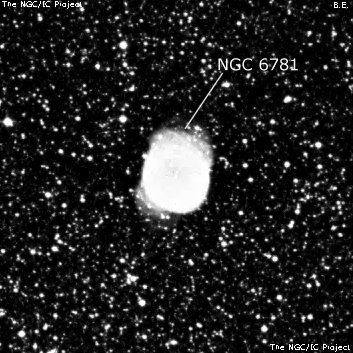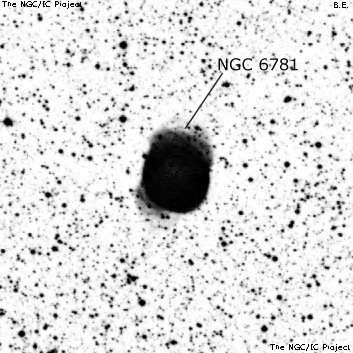NGC/IC Project Restoration Effort
(This is a very very beta version)
NGC6781


Basic Information
Location and Magnitude
Right Ascension: 19:18:28.3
Declination: +6:32:25
Constellation: AQL
Visual Magnitude: 11.4
Historic Information
Discoverer: Herschel W.
Year of discovery: 1788
Discovery aperture: 18.7
Observational
Summary description: planetary, F, L, R, vsbM disc, S * nf
Sub-type: PN
Corwin's Notes
=====
NGC 6781. The position is for a very faint, very blue star -- the
southeastern of two -- near the geometric center of the planetary. The star
is not seen at all in any of the 2MASS images, but is clear on the DSS2B
image.
Steve's Notes
=====
NGC 6781
24" (6/30/16): at 322x and 500x; fairly bright and large, round, just under 2' diameter. Contains a relatively thick, much brighter rim, except on the north side. The annulus is unevenly in surface brightness, but brighter along a 180¡ arc, centered on the side south and dimming gradually but extending ~240¡. This gives the planetary a "C" shape appearance. The remaining 120¡ arc, centered on the north edge, is noticeably fainter. A mag ~13.5 star is at the northeast edge, a mag ~14.5 star is just off the north-northwest edge and a mag 15.5+ star is barely off the south edge. An extremely faint star is superimposed just north-northeast of center (probably not the central star).
18" (7/14/07): at 225x appeared fairly bright, fairly large, round, perhaps 1.8' diameter. A brighter rim is evident, particularly along the entire south half and extending for nearly 180 degrees. The rim is weaker on the north side giving a partial thick "C" or crescent appearance. A mag 13.5 star is at the northeast edge.
18" (8/14/04): at 225x, appears moderately bright, fairly large, round, at least 1.5' diameter. A mag 13.5 star is at the NE edge of the rim with a fainter star off the NNW edge. The rim is clearly brighter, particularly along the entire south side, with the rim fading on the north side giving an asymmetric or crescent appearance. A large central "hole" appears slightly darker. At 160x, one or possible two extremely faint stars flickered on and off within the interior of the disc but neither appeared to be the central star.
17.5" (6/30/00): at 220x unfiltered this fairly bright PN has a 1.5' round halo. The rim is brightest and more well-defined along an arc on the south and southeast rim. The central 45" hole is slightly darker and irregular in surface brightness. A mag 13 star is at the northeast edge and once or twice I caught a fainter glimmer of an interior star north of center.
17.5" (7/12/99): at 100x appears fairly bright, round, ~1.6' diameter with a darker center. I used a variety of magnifications and filters but the most interesting view was at 220x using a UHC filter. With this combination the PN is slightly elongated E-W and clearly brighter along the southern rim with the brightening tapering towards the ends so this brighter portion had a crescent appearance. Because of this asymmetric rim the darker center seems offset and only weakly brightens at the NW rim. A mag 13 star is just off the NE edge 1' from center.
17.5" (8/2/86): at 222x and UHC filter; very large, about 1.8' diameter, much brighter on the SW portion of the rim, darker center. A mag 13 star is just off the NE edge.
13.1" (6/29/84): the rim is brighter mainly on the SW side giving a slightly annular appearance. A faint star is off the east edge.
13.1" (8/15/82): brighter rim mostly evident on the south side and a darker center just visible at 140x-200x.
8" (7/24/82): large and easily viewed but the annularity was not seen with any certainty.



